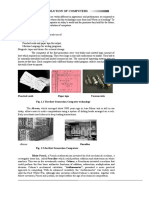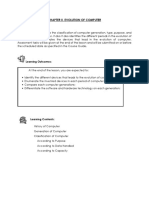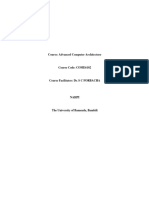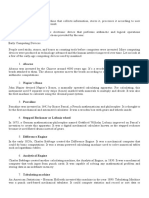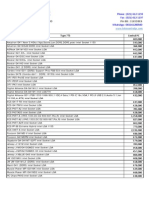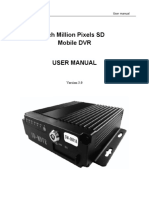Chapter Two
Development of Computers
2.1. History of Computer
History of computer could be traced back to the effort of man to count large numbers. This
process of counting large numbers generated various systems of numeration like Babylonian
system of numeration, Greek system of numeration, Roman system of numeration and Indian
system of numeration. Out of these the Indian system of numeration has been accepted
universally. It was the basis of modern decimal system of numeration (0, 1, 2, 3, 4, 5, 6, 7, 8,
and 9). Later you will know how the computer solves all calculations based on decimal system.
But you will be surprised to know that the computer does not understand the decimal system
and uses binary system of numeration for processing.
2.2. Evolution of computer
Calculating Machines
It took over generations for early man to build mechanical devices for counting large numbers.
The first calculating device called ABACUS was developed by the Egyptian and Chinese people.
The word ABACUS means calculating board. It consisted of sticks in horizontal positions on
which were inserted sets of pebbles. It has a number of horizontal bars each having ten beads.
Horizontal bars represent units, tens, hundreds, etc.
Napier’s bones
English mathematician John Napier built a mechanical device for the purpose of multiplication
in 1617 AD. The device was known as Napier’s bones.
Slide Rule
English mathematician Edmund Gunter developed the slide rule. This machine could perform
operations like addition, subtraction, multiplication, and division. It was widely used in Europe
in 16th century.
Pascal's Adding and Subdirectory Machine
You might have heard the name of Blaise Pascal. He developed a machine at the age of 19 that
could add and subtract. The machine consisted of wheels, gears and cylinders.
1
�Leibniz’s Multiplication and Dividing Machine
The German philosopher and mathematician Gottfried Leibniz built around 1673 a mechanical
device that could both multiply and divide.
Babbage’s Analytical Engine
It was in the year 1823 that a famous English man Charles Babbage built a mechanical machine
to do complex mathematical calculations. It was called difference engine. Later he developed a
general-purpose calculating machine called analytical engine. You should know that Charles
Babbage is called the father of modern computer.
Babbage’s assistant, Augusta Ada King, she designed instruction routines to be fed into the
computer, making her the first female computer programmer.
Mechanical and Electrical Calculator
In the beginning of 19th century the mechanical calculator was developed to perform all sorts
of mathematical calculations. Up to the 1960s it was widely used. Later the rotating part of
mechanical calculator was replaced by electric motor. So it was called the electrical calculator.
Modern Electronic Calculator
The electronic calculator used in 1960 s was run with electron tubes, which was quite bulky.
Later it was replaced with transistors and as a result the size of calculators became too small.
The modern electronic calculator can compute all kinds of mathematical computations and
mathematical functions.
It can also be used to store some data permanently. Some calculators have in-built programs to
perform some complicated calculations.
2.3. Generation of Computer
You know that the evolution of computer started from 16th century and resulted in the form
that we see today. The present day computer, however, has also undergone rapid change
during the last fifty years. This period, during which the evolution of computer took place, can
be divided into five distinct phases known as Generations of Computers.
Each phase is distinguished from others on the type of switching circuit elements, secondary
storage device, memory access time, I/O device, operating system and programming language.
2
�2.3.1. First Generation Computers (1940-1956)
Used vacuum tubes or thermionic valve as a circuitry.
Have small internal memory based on magnetic drums or relays.
Input device is based on punched card or paper tape.
Output is displayed on printouts.
Use machine or low level language.
Access time measured in milliseconds (thousands of a second 10-3).
Consists’ about 1,000 circuits per cubic foot.
Require extreme air conditioning system.
Designed for both alphabetic and numeric uses. Slow in computations. These
computers were large in size and writing programs on them was difficult.
Some of the computers of this generation were:
ENIAC: It was the first electronic computer built in 1946 at University of Pennsylvania, USA by
John Eckert and John Mauchly. It was named Electronic Numerical Integrator and Calculator
(ENIAC). The ENIAC was 30 X 50 feet (9.144 X 15.24 meter) long, weighed 30 tons, contained
18,000 vacuum tubes, 70,000 registers, 10,000 capacitors and required 150,000 watts of
electricity. Today your favorite computer is many times as powerful as ENIAC, still size is very
small.
EDVAC: It stands for Electronic Discrete Variable Automatic Computer and was developed in
1950. The concept of storing data and instructions inside the computer was introduced here.
This allowed much faster operation since the computer had rapid access to both data and
instructions. The other advantage of storing instruction was that computer could do logical
decision internally.
EDSAC: It stands for Electronic Delay Storage Automatic Computer and was developed by M.V.
Wilkes at Cambridge University in 1949.
UNIVAC-1: Eckert and Mauchly produced it in 1951 by Universal Accounting Computer setup.
Limitations of First Generation Computer
Followings are the major drawbacks of First generation computers.
The operating speed was quite slow.
Power consumption was very high.
It required large space for installation.
The programming capability was quite low.
3
�2.3.2. Second Generation Computers (1956-1963)
Use transistors as a main circuitry rather than vacuum tubes.
Use magnetic core or tape as storage device.
Output was displayed on printout.
Use assembly language
Batch operating systems are used that permitted rapid processing of magnetic tape
files.
Consists of about 100,000 circuits per foot.
Access time measured in microseconds (10-6).
Smaller and faster than first generation computer
Manufacturing cost was also very low. Thus the size of the computer got reduced
considerably.
In this, second generation that the concept of Central Processing Unit (CPU), memory,
programming language and input and output units were developed. The programming
languages such as COBOL, FORTRAN were developed during this period. Some of the computers
of the Second Generation were
1. IBM 1620: Its size was smaller as compared to First Generation computers and mostly used
for scientific purpose.
2. IBM 1401: Its size was small to medium and used for business applications.
3. CDC 3600: Its size was large and is used for scientific purposes.
2.3.3. Third Generation Computers (1964-1970)
Use integrated circuit (IC) instead of transistors
Use IC based (magnetic disk) as storage device.
10 million circuits per square foot.
New input/output devices, like the key board and visual display unit/VDU/monitor
were developed
Access time in 100 nanoseconds (100*10-9)
Cheaper and made commercial production easier.
Software become more important with sophisticated operating systems, improved
programming languages,
The size of the computer got further reduced. Some of the computers developed
during this period were IBM-360, ICL-1900, IBM-370, and VAX-750. Higher level
language such as BASIC (Beginners All purpose Symbolic Instruction Code) was
developed during this period.
4
� 2.3.4. Fourth Generation Computers (1970s to present)
It is extension of the 3rd generation computers.
Introduce very large scale integrated circuit or VLSI technology.
Widely known for the use of microprocessors
Circuit density approached 100,000 components per chip and above.
Access time approached nanoseconds.
Programming task were simplified
Virtual operating systems were introduced for multiple use
Are versatile in nature and are also able to form a network.
The present day computers that you see today are the fourth generation.
Due to the development of microprocessor it is possible to place computer’s central
processing unit (CPU) on single chip.
E.g. IBM system 3090, IBM RISC 6000, HP 9000, IBM PC (1980), Pentium I, Pentium II.
2.3.5. Fifth Generation Computer (future computer)
Characterized by the use of artificial intelligence and natural language.
Aimed at narrowing the gap between people and computer.
To achieve human like qualities of intelligence including the ability to reason.
Table 2.1 major differences between generations
1st generation 2nd generation 3rd generation 4th generation
Circuit element Vacuum tube Transistor IC LSIC/VLSIC
Secondary Punched card Magnetic Tape Magnetic disk Mass storage
Storage D device
Programming Machine or low Assembly High level e.g. BASIC High level
Language level language
Operating system Operator control Batch system sophisticated OS Time sharing
Memory Access milliseconds (10-3) microseconds 100 nanoseconds 1 nanoseconds
Approx.
time date 1940-56 (10-6)
1956-63 1964-70 From 1970
Power Very high High Low Low
above
Characteristics
consumption Single purpose, Single purpose, General purpose, Very versatile,
large, expensive, smaller, smaller, cheaper, easier cheap,
unreliable, hard to cheaper, easier to use powerful,
use to use small, easy to
use
Examples ENIAC, UNIVAC, IBM 1620, IBM IBM-360, ICL-1900, IBM PC (1980)
UDVAC 1401, CDC 3600 IBM-370, and VAX-750.
5
�6










